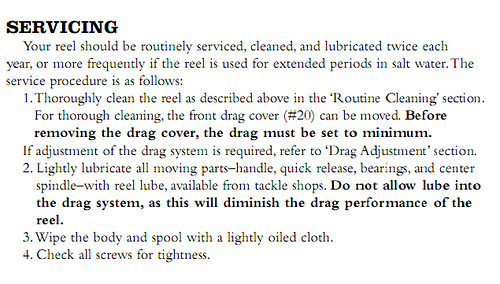Considering that we don't have to quit fishing in the Winter like the folks in New England and the Rocky Mountains!!! Yahooo! From our friends at Orvis....
Pro Tip: Cleaning and storing your gear for the off-season
 |
For many of us, the fishing season never ends, but for those who do put away some of their equipment—dry-fly rods, the 2-weight you use for native brookies, etc.—for the long winter, storage is important. Although most fishing gear will last for years if you treat it right, incorrect storage can shorten that life span or ruin the aesthetics of a fine rod or reel. For instance, C. Boyd Pfeiffer, the godfather of tackle craft, tells of how he put a fly rod away wet, and when he retrieved it in the spring it was covered by tiny white blisters under the finish. Here are some tips to help you avoid such an unwelcome surprise.1. The end of the season is the perfect time to clean all your gear. Before you store rods, reels, waders, and lines, you should wash them and allow them to completely dry.
Rods: An old toothbrush is perfect for lightly scrubbing around the hardware and guides. Pfeiffer notes that taking several rods into the shower with you is a convenient way to get the job done quickly. Make sure you rinse the rods thoroughly and allow them to air dry.
Reels: You can use the same toothbrush for getting all sand, salt, and grime off your reels. Take the lines off all reel before you wash them (although you can leave the backing on). Again make sure you rinse all parts thoroughly and put them on a towel to dry. When one side is completely dry, flip the parts over, so any water hiding in nooks and crannies can run out. Do this a few times.
Waders: Rinse them completely, wiping off any dirt or salt, and hang them to dry. Then turn them inside out an allow them to hang for awhile longer to air them out.
Fly lines: Always follow the manufacturer’s instructions for cleaning your lines. Using dish soap will actually remove the slick coating. A moist rag will usually do the trick.
2. Now it’s time to inspect and perform routine maintenance.
Rods: Check all the guides and ferrules to ensure they are in good shape. Apply ferrule wax to the male ends of the ferrules. Check the reel seat to make sure the threads are clear of debris.
Reels: If your reel requires lubricant (although few modern models do), follow the manufacturer’s instructions for doing so. Make sure all screws are tight. Do a final inspection to see if you missed any sand or salt residue.
Waders: Check them for wear and tear or leaks. If there are abrasions or nicks that look like they may become leaks, you might want to do a prophylactic repair with a patch kit.
Fly lines: Check the line for nicks, and test the loops at both ends to ensure that they are still strong.
3. Storing your gear correctly will ensure that it’s good as new when you need it.
Rods: Again, make sure the rod is completely dry before you put it in its sock or tube. Arrange your rod tubes horizontally, rather than standing upright. Finally, Pfeiffer suggests that you leave the end caps off entirely to allow the rods to “breathe” during the long months of storage.
Reels: The big enemy of reels is corrosion, so make sure they are fully dry. You can choose to store them in their bags, but leave a gap in the opening to allow any moisture to escape. Before you put a reel away for the winter, back the drag off completely. This will reduce wear and tear on the discs or other components.
Waders: The best way to store breathable waders is to hang them, but not by the suspenders or the boot feet. Instead, drape them over a hanger, allowing air to circulate all around them. This way, you don’t stress the suspenders or where the wader and boot material come together.
Fly lines: Fly lines should be clearly labeled and hung in loose coils over a hook or a nail. This will keep them from developing too much memory over the winter.
Guide Joe Demalderis says that, if your don't want to take the lines off the reels, leave your line attached to the spool and lightly coil the line around a large coffee can. Then toss the reel or spool into the can and snap the plastic lid on over the backing. The tension from the lid doesn't hurt the backing. Now your lines are stored in a less-memory-setting situation and your reels or spools are protected from dust and grime.
It goes without saying that all your gear should be stored somewhere that’s dry and is relatively climate-controlled—that is, a place that doesn’t experience wide swings in temperature.




No comments:
Post a Comment